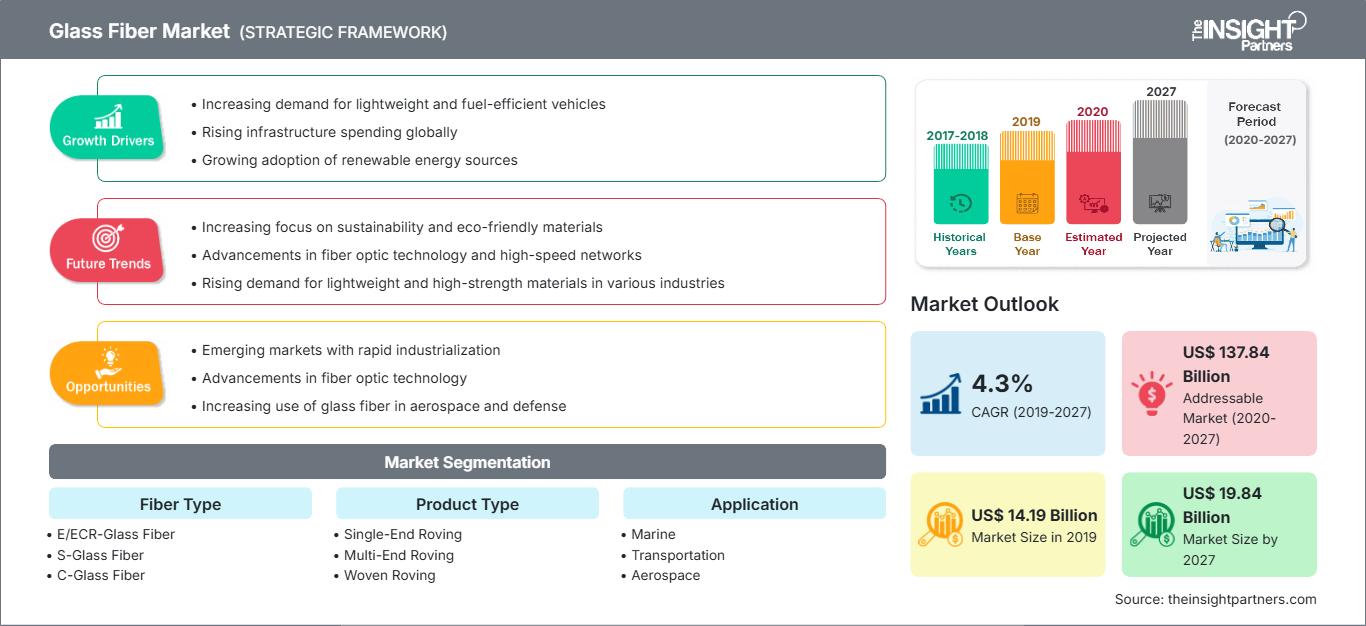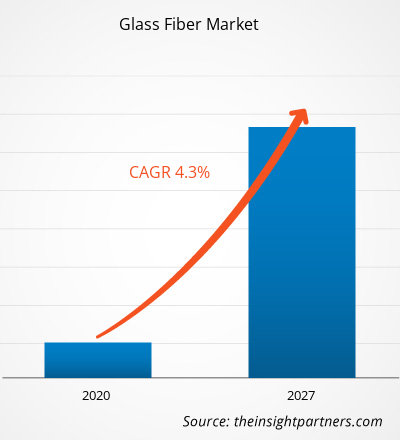2019 年玻璃纤维市场价值为 141.9355 亿美元,预计到 2027 年将达到 198.3762 亿美元,2020 年至 2027 年的复合年增长率为 4.3%。
玻璃纤维是一种由极细玻璃丝组成的材料,这些玻璃丝被组合成纱线并编织成织物。它是通过在三级熔炉中混合和熔融二氧化硅 (SiO2)、石灰石和纯碱,将熔融的玻璃通过前炉底部的衬套挤出,然后用水冷却细丝而制成的。玻璃纤维具有优异的耐腐蚀性、更高的刚度和强度、高拉伸强度以及耐高温和耐用性。这些纤维广泛应用于汽车、建筑、船舶、风能以及航空航天和国防等终端行业。然而,生产工艺的挑战、新技术的成本密集型以及玻璃纤维的低利润率限制了市场的增长。
2019 年,亚太地区在全球玻璃纤维市场中占有最大份额,预计未来几年亚太地区将成为增长最快的玻璃纤维市场。随着运输、建筑、电气和电子、航空航天和其他行业的增长,该地区对玻璃纤维的需求大幅上升。建筑行业是玻璃纤维的主要消费者之一。印度和中国等新兴市场的快速基础设施建设推动了对先进玻璃纤维的需求。例如,印度政府为改善住宅和交通基础设施做出了巨大努力。根据印度工业和内部贸易促进部 (DPIIT) 的数据,2000 年 4 月至 2020 年 9 月期间,建筑开发领域和基础设施活动的外国直接投资 (FDI) 分别为 257.8 亿美元和 172.2 亿美元。持续的基础设施建设投资将大幅推动玻璃纤维的消费。此外,玻璃纤维还用于船舶、机翼能源和消费品行业,这些行业也得到了政府的大力投资,从而支持了该地区玻璃纤维市场的增长。
COVID-19 于 2019 年 12 月在中国武汉首次爆发,此后迅速蔓延至全球。截至 2021 年 3 月,美国、印度、巴西、俄罗斯、法国、英国、土耳其、意大利和西班牙是确诊病例和死亡人数最多的国家。由于封锁、旅行禁令和企业倒闭,COVID-19 疫情已影响到各国的经济和产业。此外,欧洲、亚洲和北美国家实施的全球旅行禁令也影响了商业合作和伙伴关系机会。所有这些因素预计都会对化学品和材料行业产生负面影响,从而成为玻璃纤维市场增长的制约因素。
自定义此报告以满足您的要求
您将免费获得任何报告的定制,包括本报告的部分内容,或国家级分析、Excel 数据包,以及为初创企业和大学提供超值优惠和折扣
玻璃纤维市场: 战略洞察

- 获取本报告的主要市场趋势。这个免费样本将包括数据分析,从市场趋势到估计和预测。
市场洞察:建筑行业对玻璃纤维的需求不断增长
您将免费获得任何报告的定制,包括本报告的部分内容,或国家级分析、Excel 数据包,以及为初创企业和大学提供超值优惠和折扣
玻璃纤维市场: 战略洞察

- 获取本报告的主要市场趋势。这个免费样本将包括数据分析,从市场趋势到估计和预测。
玻璃纤维在建筑行业中用作隔热材料、表面涂层、覆层和屋顶原材料。它们价格低廉,且具有与其他纤维(包括聚合物和碳纤维)大致相当的机械性能,例如刚度、柔韧性、透明度、耐化学腐蚀性和惰性。玻璃纤维用于玻璃纤维增强混凝土,这种混凝土用于建造墙壁、壁炉周围、地基、覆层、盥洗台面和混凝土台面。它主要用于建筑外墙板和建筑预制混凝土。玻璃纤维作为主要载体,提供高抗拉强度,使混凝土具有柔韧性和抗开裂性。耐碱玻璃纤维 (ARGF) 广泛应用于建筑材料中。ARGF 显著提高了混凝土的抗拉强度、弯曲韧性、断裂模量和耐磨性。这种混凝土用于防止裂缝,因此在建筑领域得到广泛应用。
全球建筑业的快速发展预计将增加对玻璃纤维的需求。美国等发达国家新建住宅建筑支撑了对玻璃纤维的需求。例如,根据美国人口普查局的数据,2020 年 3 月,美国获准建造的住宅单元总数年率为 1,353,000 套,较 2019 年 3 月增长 5%。此外,中国和印度等新兴市场的强劲经济增长带动了基础设施建设的蓬勃发展。这些国家正在经历新建筑建设的增加;现有建筑的维护和维修、改建或翻新;预制构件的现场组装;临时建筑的建造;以及电梯和自动扶梯等专用建筑设施的安装。预计所有这些因素都将在建筑行业创造对玻璃纤维的持续需求。
纤维类型洞察
根据纤维类型,全球玻璃纤维市场细分为
E/ECR玻璃纤维、S玻璃纤维、C玻璃纤维和其他。E/ECR玻璃纤维细分市场在2019年占据玻璃纤维市场主导地位,市场份额最高。E玻璃纤维是一种电子玻璃,是主要的玻璃纤维类型之一,具有强度高、绝缘性好、防水和耐腐蚀等特性。E玻璃纤维是所有纤维增强材料和纤维增强复合材料中应用最广泛的,因为它们比其他玻璃纤维成本合理、弹性模量低且开发较早。另一方面,ECR玻璃类似于E玻璃,但不含氟和硼。 ECR玻璃纤维环保,具有优异的耐酸性、耐水性、耐高温性和耐碱性。此外,ECR玻璃纤维还具有优异的介电强度、较低的漏电和更高的表面电阻。ECR玻璃纤维自2005年1月起按照ASTM-D578-1999标准生产,适用于除透明玻璃纤维增强塑料(FRP)面板应用外的所有电子玻璃应用。E/ECR玻璃纤维在汽车、电子产品和电子设备中的广泛应用预计将在预测期内推动该细分市场的增长。
产品类型分析
根据产品类型,全球玻璃纤维市场细分为
单端粗纱、多端粗纱、编织粗纱和其他。 2019 年,其他细分市场引领了全球玻璃纤维市场。其他细分市场包括织物、CSM、CFM、DUCS、CS、OptiSpray 粗纱、Cem-FILRoving。
直接粗纱等。OptiSpray 粗纱为制造商提供了一种极具吸引力的解决方案,可以帮助他们节省时间和树脂,同时提高产品性能。Cem-FIL 粗纱是一种耐碱玻璃纤维组装粗纱,用于通过同时喷涂法制造玻璃纤维增强混凝土复合材料。Cem-FILRoving 具有耐碱玻璃、良好的解卷性、易于切碎和高分割效率等优点,非常适合用于复杂轮廓和出色的机械性能。欧文斯科宁等制造商提供 OptiSpray F 粗纱、Cem-FILRoving 5325、Cem-FILRoving 62.4 和 Cem-FIL 粗纱 62/70。圣戈班维特泰克斯公司提供直接粗纱(Direct Roving),这是一种由无碱玻璃(E-Glass)制成的无接头单端粗纱,适用于多种纺织技术。
应用洞察
根据应用,全球玻璃纤维市场细分为
海洋、运输、航空航天、建筑、电气和电子、消费品和其他领域
。
运输行业在2019年引领了全球玻璃纤维市场。玻璃纤维用于运输行业,例如车顶板、车门、车窗、冷却通风机、行李箱、座椅和头枕背板。玻璃纤维具有更高的强度重量比,这是制造汽车的重要因素。预计这些因素将在预测期内推动运输行业玻璃纤维市场的增长。制造工艺洞察
根据制造工艺,全球玻璃纤维市场细分为手糊、喷射、预浸料铺层、注塑、模压、树脂灌注等。2019 年,“其他”细分市场引领了全球玻璃纤维市场。“其他”细分市场包括拉挤成型、离心铸造、注塑/热成型混合等。拉挤成型是一种低成本、简单、连续的工艺,几十年来一直用于玻璃纤维和聚酯树脂。近年来,该工艺也已应用于先进的复合材料领域。拉挤成型可生产光滑的成品零件,通常无需后处理。在离心铸造法中,环氧树脂或乙烯基酯树脂被注入150G离心纺丝模具中,渗透到包裹模具内表面的编织物中。
Johns Manville、巨石股份有限公司、重庆国际复合材料股份有限公司 (CPIC)、Goa Glass Fiber Ltd、日本电气硝子株式会社、Saint-Gobain Vetrotex、四川威博新材料集团有限公司、泰山玻璃纤维股份有限公司、台湾玻璃集团和欧文斯科宁是玻璃纤维市场的主要参与者。这些公司在全球范围内提供产品,这有助于他们满足更广泛的客户群。这些主要市场参与者高度专注于开发高质量和创新产品,以满足客户的需求。在过去几年中,市场上的公司已经意识到玻璃纤维市场的巨大潜力,并积极参与并购和产品发布等战略。例如,2020年,巨石推出E9超高模量玻璃纤维,用于推动轻量化风电叶片的发展。
玻璃纤维市场
The Insight Partners 的分析师已详尽阐述了预测期内影响玻璃纤维市场的区域趋势和因素。本节还讨论了北美、欧洲、亚太地区、中东和非洲以及南美和中美洲的玻璃纤维市场细分和地域分布。
玻璃纤维市场报告范围
| 报告属性 | 细节 |
|---|---|
| 市场规模 2019 | US$ 14.19 Billion |
| 市场规模 2027 | US$ 19.84 Billion |
| 全球复合年增长率 (2019 - 2027) | 4.3% |
| 历史数据 | 2017-2018 |
| 预测期 | 2020-2027 |
| 涵盖的领域 |
By 光纤类型
|
| 覆盖地区和国家 | 北美
|
| 市场领导者和主要公司简介 |
|
玻璃纤维市场参与者密度:了解其对业务动态的影响
玻璃纤维市场正在快速增长,这得益于终端用户需求的不断增长,而这些需求又源于消费者偏好的不断变化、技术进步以及对产品优势的认知度不断提升等因素。随着需求的增长,企业正在扩展产品线,不断创新以满足消费者需求,并抓住新兴趋势,从而进一步推动市场增长。

- 获取 玻璃纤维市场 主要参与者概述
- 全球玻璃纤维市场不断发展的行业趋势,帮助参与者制定有效的长期战略
- 发达市场和发展中市场采用的业务增长战略
- 2017 年至 2027 年全球玻璃纤维市场的定量分析
- 各行业对玻璃纤维的需求估计
- PEST 分析,说明行业买家和供应商预测市场增长的有效性
- 了解竞争激烈的市场状况和对玻璃纤维的需求的最新发展
- 市场趋势和前景,以及推动和抑制玻璃纤维市场增长的因素
- 通过了解支撑全球玻璃纤维市场增长的商业利益的策略来进行决策过程
- 不同市场节点的玻璃纤维市场规模
- 全球玻璃纤维市场的详细概述和细分及其行业动态
- 不同地区的玻璃纤维市场规模前景光明的增长机会
全球玻璃纤维市场,按纤维类型
- E/ECR 玻璃纤维
- S 玻璃纤维
- C 玻璃纤维
- 其他
全球玻璃纤维市场,按产品类型
- 单端粗纱
- 多端粗纱
- 编织粗纱
- 其他
全球玻璃纤维市场,按应用
- 海洋
- 运输
- 航空航天
- 建筑
- 电气和电子
- 消费品
- 其他
全球玻璃纤维市场,按制造工艺
- 手糊
- 喷涂
- 预浸料铺层
- 注塑成型
- 模压成型
- 树脂灌注
- 其他
公司简介
- 重庆国际复合材料股份有限公司
- Johns Manville
- 中国巨石股份有限公司
- 日本电气硝子株式会社
- 欧文斯科宁
- 圣戈班公司
- 四川威博新材料集团有限公司
- 泰山玻璃纤维股份有限公司
- 台湾玻璃集团
- 果亚玻璃纤维有限公司
- 历史分析(2 年)、基准年、预测(7 年)及复合年增长率
- PEST和SWOT分析
- 市场规模、价值/数量 - 全球、区域、国家
- 行业和竞争格局
- Excel 数据集
近期报告
相关报告
客户评价
购买理由
- 明智的决策
- 了解市场动态
- 竞争分析
- 客户洞察
- 市场预测
- 风险规避
- 战略规划
- 投资论证
- 识别新兴市场
- 优化营销策略
- 提升运营效率
- 顺应监管趋势




















 获取免费样品 - 玻璃纤维市场
获取免费样品 - 玻璃纤维市场